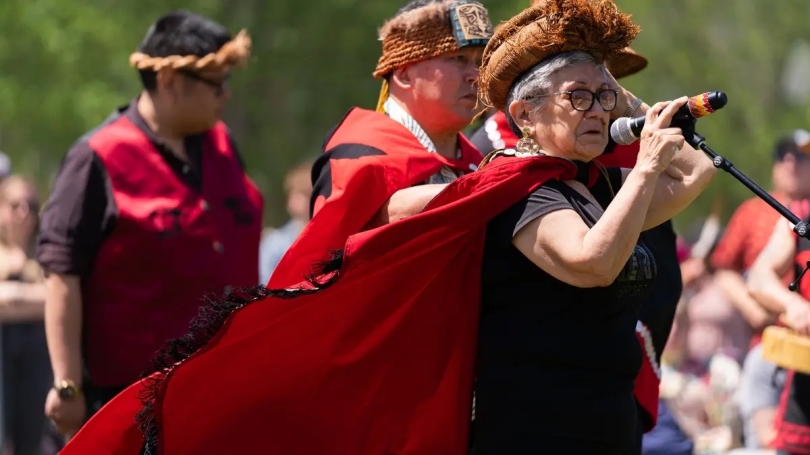
LEFT Margaret Hill, wearing her ancestor’s Gitxaała Nation headdress, speaks at the repatriation ceremony on Saturday. Photo by Julia Levine ’23.
Native American Graves Protection and Repatriation Act (NAGPRA) & Repatriation
The Native American Graves Protection and Repatriation Act (NAGPRA), signed into law in 1990, provides a legal framework within which federally recognized Indian tribes and Native Hawaiian organizations can request the return of ancestral human remains and certain cultural items—funerary objects, sacred objects, and objects of cultural patrimony—from federal agencies, museums, and other collection-holding organizations that have received federal funds.
NAGPRA required collection-holding institutions to meet two reporting deadlines, the first for summaries of cultural items due in 1993 and the second for inventories of Native American human remains and associated funerary objects in 1995. In 1993, the Hood Museum of Art, Dartmouth, sent written summaries of cultural items to more than five hundred federally recognized tribes. In 1995, an inventory of human remains and associated funerary objects was completed and submitted to the National NAGPRA Program, and several "Notices of Inventory Completion" have since been published in the Federal Register.
For further information, contact Hood.NAGPRA@dartmouth.edu.
For more information about this federal law, visit the National Park Service NAGPRA Program website.
In 2018, the museum hired Jami Powell as its first associate curator of Native American art. Powell, a citizen of the Osage Nation, has extensive experience with NAGPRA and specifically the consultation and repatriation of Native American remains and associated funerary objects. Powell also serves as Dartmouth's NAGPRA officer. In 2022 the museum hired Emily Andrews '22 as the first full-time staff member dedicated to NAGPRA.
New information has uncovered skeletal human remains used as teaching aids in anthropology classes, which were long believed to be non-Native, are in fact Native American in origin. Faculty and students unknowingly handled these ancestral remains in classes as recently as fall 2022.
Dartmouth made the discovery during a recent effort to ensure compliance and more proactively pursue repatriation under the Native American Graves Protection and Repatriation Act (NAGPRA). Enacted in 1990, NAGPRA requires institutions like Dartmouth to make Native American ancestral remains in its possession available for repatriation.
This is a painful discovery, and President Philip J. Hanlon has offered an apology to the entire community, especially our Indigenous students, faculty, staff, and alumni.
Dartmouth has asked a team of external osteologists and archaeologists to re-inventory the collection and assist a team from the Hood Museum of Art and the Department of Anthropology to identify and repatriate these newly discovered ancestral remains.
Learn more here about how the discovery was made, what was found, and the steps Dartmouth is taking to ensure NAGPRA compliance moving forward.
In January 2024, new regulations guiding our work on NAGPRA went into effect. These new regulations require tribal consultation and approval from affiliated tribal nations before an institution can display funerary objects, objects of cultural patrimony and sacred objects—collectively called "cultural items" in the new regulations.
Our staff has carefully reviewed these regulations and taken additional steps to participate in trainings offered by the national NAGPRA program on how to maintain compliance under these new regulations. At this time, we are reaching out to Tribal Historic Preservation Officers (THPOs) and other appointed tribal representatives, speaking with colleagues, and continuing to do research relating to the provenance of the Native American collections.
While we have no specific concerns regarding current displays of items in the Hood Museum's galleries, we will, as always, honor any changes requested by tribal nations to the display and care of cultural items in our collections. We value the opportunity to work closely with tribal nations as we work to incorporate the new NAGPRA regulations into our ongoing work and will continue to work in the spirit of the law.